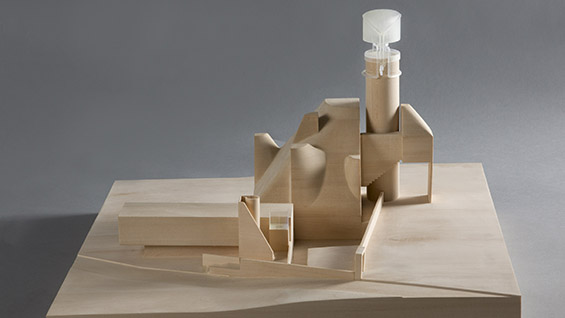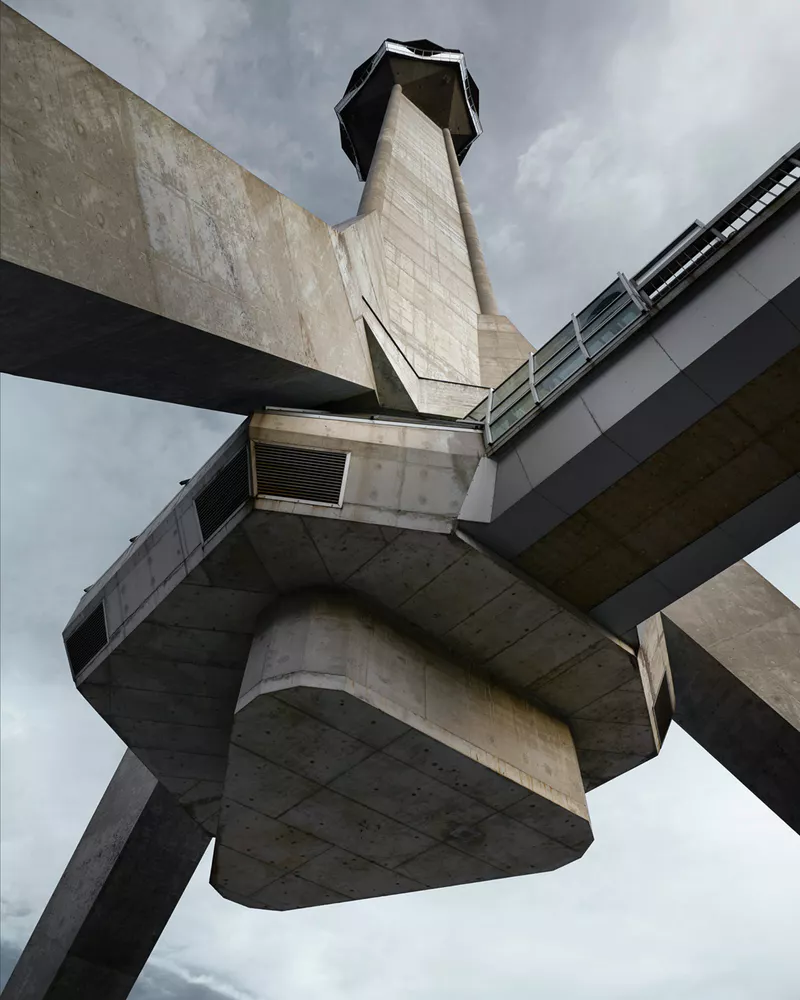
2018年7月15日—2019年1月13日在美国现代艺术博物馆展出的“走向混凝土的乌托邦:南斯拉夫的建筑,1948—1980”(Toward a Concrete Utopia: Architecture in Yugoslavia,1948—1980)受到了高度关注,在400多幅图纸,模型,照片,电影卷轴之外,展览中亦有库柏联盟(The Cooper Union)学生和校友一同构思、制作的五个精细建筑模型。
A highly lauded exhibition currently on view at the Museum of Modern Art (MoMA) about post-war modernist architecture in the former Yugoslavia features five highly-detailed, exquisitely executed architectural models conceived and fabricated by students of the Irwin S. Chanin School of Architecture some of whom are now recent graduates.


“走向混凝土的乌托邦” 呈现了1948—1980年间前南斯拉夫的建筑设计,与美国、前苏联这两个超级大国之间的区别。前南斯拉夫采取了被称之为“第三条大道”的方向,创造出建筑,纪念碑,以及整个城市的面貌,而MoMA的本次展览是一场严格的拣选。
Toward a Concrete Utopia: Architecture in Yugoslavia, 1948–1980 documents the ideas of architects tasked with designing buildings that reflected the new nation of Yugoslavia as separate from the era's two superpowers, the United States and the Soviet Union. Taking what was dubbed the "Third Way," Yugoslavia's architects created buildings, monuments, and entire cities that have largely gone unnoted by architectural historians.The exhibition at MoMA is a "rigorous examination" of the works and the key figures of the period.

在展览中,建筑项目主要以图片和图纸的方式进行展示,但这些形式自有其局限。所以,策展人Martino Stierli 与包括库柏联盟在内的多所建筑学院联系,希望院校能设计并制作有助于揭示实际建筑结构、形式、构造的模型。
In the exhibition, the architectural projects are represented by photographs and drawings that can be dense and difficult to read on their own. As a result, the show’s curator, Martino Stierli, reached out to several schools of architecture, including The Cooper Union, to design and fabricate models that could help to reveal the structure, form and tectonics of the actual buildings.
库柏联盟院长Nader Tehrani和副院长Elizabeth O'Donnell认为这一合作教学机会能使Cooper学生、毕业生更好地了解前南斯拉夫的历史,以及学校现有课程中通常不会教授的知识,并有机会仔细研究、分析所选择的每个项目。 “这是一个通过建筑讲述的、非常重要的政治及社会实验故事,我们希望通过建筑模型的设计和制作来重现这一历史。建筑模型的制作不是制造出微型建筑,它能帮助揭示出原有建筑中最本真的想法。”
Dean Nader Tehrani and Associate Dean Elizabeth O’Donnell immediately recognized the pedagogical opportunity of such a collaboration and were thrilled to offer Cooper students and alumni the chance to be part of the project. Not only would the students learn about the history of Yugoslavia and a body of work that was not typically taught in any existing class at the school, but they would have the opportunity to study and analyze each project selected for fabrication in intimate detail. “This is the story of a very important political and social experiment told through architecture, an historical moment that proved to be short-lived,” said O’Donnell. “We were eager for our students and alumni to engage that moment through the design and fabrication of architectural models, a process both analytic and conceptual that is integral to our pedagogy. Architectural model making isn't fabricating a miniature building; it’s a material construction of the building to scale, that seeks to uncover the ideas in the original architecture.”


学生和校友们的模型制作,始于对此阶段一系列历史课程的修习。他们了解到,虽然前南斯拉夫是一个社会主义国家,却从未被苏联占领,因此该国的设计师希望创造一种独特的建筑语言。最终的结果不是一个唯一的特质,出现的是一批相当开放的建筑理念,它们找寻着一种有效的共产主义建筑风格。
Students and alumni began the process by studying the era and a selection of projects in a course taught by Professor Matthew Worsnick, a Museum Research Consortium Fellow at MoMA and currently a professor of art history at Vanderbilt University. They learned that while a socialist country, Yugoslavia had never been occupied by the Soviet Union and was not part of the Communist-bloc nations, so the country’s designers looked to create a unique architectural language. Though the result was not a particular style, “what did emerge was a fairly open market of architectural ideas. They were looking for a valid communist architecture.”
学生及MoMA最终商定、建立的模型共五个,这些项目和建筑群主要由混凝土构成,兼具野兽派和未来主义色彩。它们位于前南斯拉夫各省,包括科索沃图书馆(1982),一个混凝土结构、上有近100个不同大小的半透明圆顶的构筑,其中收藏了战争期间被摧毁的阿尔巴尼亚文学作品;斯普利特的Poljud体育场(1979); 阿瓦拉电视塔(1965),它于1999年在北约轰炸中被摧毁,后来重建;维索科 ( Visoko ) 的白色清真寺 (1980),一幢内部高耸的方形建筑;以及在马其顿斯科普里的电信中心。
While learning about the history of the architecture in question, students and alumni met with Mr. Stierli and other curators to agree on which models to build, in a give-and-take to meet the interests of the students and the needs of the museum. “It was a discussion where productive intersections of interest were discovered,” Dean O’Donnell said. Organized into five groups, the participants set out to represent five projects and complexes largely constructed of concrete, at once Brutalist and futuristic. The works were located in provinces across the former Yugoslavia, including a stadium in Split, a library in Kosovo and a mosque in Bosnia. The final models were the Kosovo library (1982), a concrete structure capped by almost 100 translucent domes of different sizes that held a collection of Albanian literature destroyed during the war; the Poljud Stadium in Split (1979); the Avala TV Tower (1965), which was destroyed in NATO bombing in 1999 and later reconstructed; the White Mosque in Visoko (1980), a square-plan building with soaring interiors topped with quartered cupolas; and a telecommunications center in Skopje, Macedonia.

库柏联盟校友、设计师 Yaoyi Fan与六个团队成员一起重现了建筑师 Janko Konstantinov (1926-2010)在1953至1970年间建造的建筑理想:斯科普里的电信中心。 它的三栋建筑是一系列野兽派混凝土结构,采用了直线、拱形、圆形元素,如以玻璃封闭起的柱廊。 “这个项目在当时并未完全依照建筑师的意图实现,实际建成的作品经历了各种各样的修改,但我们的模型选择与建筑师最初的设计保持一致。”
An alumnus and designer, Yaoyi Fan (AR’18), worked with six team members on the compound in Skopje designed between 1953 and 1970 by architect Janko Konstantinov (1926–2010) from. The three-building complex is an array of concrete structures that employ rectilinear elements along with arched and circular ones such as a glass-enclosed colonnade and fan windows lining a concrete tower. "The project was not entirely realized the way the architect intended," Ms. Fan said. "There were various modifications in the built work, but in our model we chose to align with the architect's vision rather than the built work."
团队中另一位设计师Gabriel Munnich表示,“这座建筑师在当时以预制混凝土建造,这在当时属于先进技术。而在本次模型制作中,我们使用3D打印来实现同样的建筑形态,与过往类似的层层叠加,是希望跨越时空、保存下建筑师当时的愿景”。
An alumnus and designer, Gabriel Munnich (AR’18), as part of the team, said that “ The building was built though precast concrete at that time, and consider as huge advancement in building technology to archive the forms and design that architect wanted. In the model, we use 3D printing to arrive the same results. The layering of the plastic in the printer similar as the layering of concrete. Our team try our best to bring the architect’s vision cross time.” The team include five other member : Jeremy Son, Chong Gu, ShuQing Zhan, Xiaohan Bao, Xinyi Guo.


模型于2017—2018学年完成,于2018年6月向MoMA运输。 Worsnick教授认为,模型制造者深度参与了整个过程,他们与当年的建筑师思考了相似的议题。 由于MoMA的本次展览,这些曾被忽视的建筑物正重新受到关注,比如目前正计划修复的科索沃图书馆。
The teams, who earned a stipend for their work, developed the projects throughout the 2017-2018 academic year. The models were finished and picked up for transportation to MoMA in June 2018, just a month after they had completed final exams. Professor Worsnick noted that students and alumni “knew how to make in the way that most architecture students and designers don’t—and they really engaged in a deep way. They were thinking of MoMA as a client, but also the original architects as clients—keeping both in mind.” And most importantly, students entered into a dialogue with the architects of the buildings, “engaging with the same problems as the original designers faced." As a result of the Museum of Modern Art exhibition, these once understudied buildings are the objects of renewed attention. The restoration of the Kosovo Library is currently being planned.

以下是展览中的部分作品:










版权声明:本文由译者樊垚远授权有方发布,有删改。欢迎转发,禁止以有方编辑版本转载。图片版权均归原作者所有。
投稿邮箱:media@archiposition.com
上一篇:得体与原型:东岸三桥 / GOM高目建筑
下一篇:建筑地图38 | 漫步台中